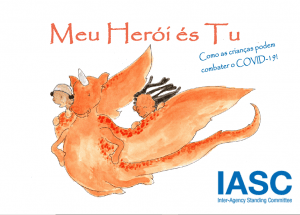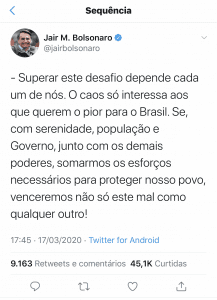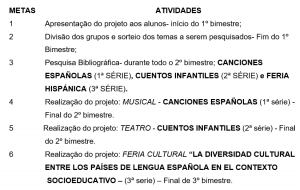ORIGINAL ARTICLE
SILVA, Lucimar de Cássia Fonseca [1]
SILVA, Lucimar de Cássia Fonseca. The cartoon as an input in the cognitive processes of readers: a reflection on the use in loco. Revista Científica Multidisciplinar Núcleo do Conhecimento. Ano. 07, Ed. 09, Vol. 08, pp. 210-226. Setembro de 2022. ISSN: 2448-0959, Access link: https://www.nucleodoconhecimento.com.br/lyrics/the-cartoon
“A natureza do humor é ser contra. Contra a autoridade, o estabelecido. A natureza do humor é revelar o que está escondido por trás da aparente normalidade, do poder.” Claudius Ceccon-brazilian cartoonist.
ABSTRACT
Intellectual disability negatively interferes with the language development of people who live in a context of technological advances, where, more and more, they are subjected to the reading of diverse multisemiotic or non-semiotic texts. In this context, it appears that cartoons, a journalistic text with wide circulation in social media and that addresses everyday facts, can be an ally for the development of these students’ cognitive processes. Therefore, this article sought to answer: how can cartoons help students, especially those who have some limitation in terms of mental ability, to develop their intellectual capacity? Therefore, the objective is to bring some notes and reflections on the use of the textual genre cartoon as a teaching object to stimulate reading and the ability to interpret texts by students who have some type of intellectual disability. In the search for answers, it was decided to carry out a bibliographic review, based also on the author’s observance of educational practices in loco during Portuguese Language classes in the Education of Young People and Adults with intellectual disabilities. Finally, it was understood that the cartoon is useful to boost the cognitive processes focused on perception, attention, memory and thinking of those who need more imagery stimuli to develop linguistically.
Keywords: Cartoon, Cognition, Language.
1. INTRODUCTION
Currently, image resources used in texts contribute to making educational practices more inclusive and, in this sense, increasingly boost the cognitive processes of the student body, which often faces great difficulty with reading and writing given the arbitrariness of the sign. In this context, if the subject is not endowed with the ability to make the association between the signifier/concept and the meaning/acoustic image in his mind, an abstraction will occur instead of the concrete object. Thus, the interpretation of oral and written texts will be compromised (SAUSSURE, 1995).
Therefore, this article addresses the characteristics of the textual cartoon genre and suggests it as a relevant text in the applicability of pedagogical activities for the exercise of the Portuguese language in the classroom.
The choice of theme arose from the author’s training in the field of letters; and, above all, by perception − arising from the pedagogical practices of teaching in loco in Youth and Adult Education (EJA)[2] with difficulties in interpreting texts, as well as the interest of students in cartoons, especially when the theme is football and/or politics. The vehemence for the deeper discussion of this textual genre is also due to the humorous character provoked by it, many times, by the non-verbal language and the caricature of the characters, as well as its way of critically observing things, people and objects.
For these reasons, it is considered sine qua non to work with texts that establish a relationship between the word, the sound and the image, which helps the teacher to stimulate the development of the cognitive processes of students who have reading and interpretation difficulties, which is often related to some degree of intellectual disability.
In this way, paying attention to the development of the teaching and learning process of more attractive and effective reading practices for students, as well as considering how much text illustration can contribute to their learning and to the construction of linguistic knowledge, the This article aims to answer: how cartoons can help the student, especially those who have some limitation in terms of mental ability, to develop their intellectual capacity? Therefore, the objective is to bring some notes and reflections on the use of the textual genre cartoon as a teaching object to stimulate reading and the ability to interpret texts by students who have some type of intellectual disability.
Motivated by these observations, emphasis will be given to the characteristics of the cartoon, as well as its construction and why it is important to have it as an object of teaching in the classroom. Some analyzes were also developed on how the subject reader can be attracted by cartoons and, consequently, is able to learn to attribute meaning to this type of text. For this, the present article was based on the analysis of Bakhtin’s discourse (2003) and Mazière (2007); in the guidelines of the National Common Curricular Base (BNCC)[3] (BRASIL, 2018; 2021) for working with multisemiotic texts; in the definitions of the cartoon genre brought by Brait (1996) and Guimarães (2013); among other studies.
2. SUBJECT READER IN CONTRAST WITH THE DIVERSITY OF TEXTUAL GENRES
In general, it is understood that textual genres have an important social function in the organization of oral and written discourses, notably, “each particular utterance is individual, but each field of use of the language elaborates its relatively stable types of utterances” (BAKHTIN , 2003, p. 262, emphasis added).
The aforementioned author further states that
a riqueza e a diversidade dos discursos são infinitas porque são inesgotáveis as possibilidades da multiforme atividade humana e porque em cada campo dessa atividade é integral o repertório de gêneros do discurso, que cresce e se diferencia à medida que se desenvolve e se complexifica um determinado campo (BAKHTIN, 2003, p. 262).
In this way, discursive and textual genres become innumerable and are always subject to changes and adaptations according to the need for communication. However, each one has its particularity focused on the context of use, in other words, on the situation and purpose of the communication. In this context, it is up to the reader, during the process of developing his communicative skills – which also depends on his mental aptitude, his social and school life – to continue learning and storing in his mind, different characteristics of countless types of texts, as well as the situations of uses which circulate.
According to the International Classification of Diseases (ICD-10, 1993), intellectual disability or mental retardation is understood as a deficit that compromises people’s cognitive functions, which makes it difficult for them to understand and learn things, which includes aspects linguistic and enunciative elements that arrange a text. This handbook also describes mental retardation as a
parada do desenvolvimento ou desenvolvimento incompleto do funcionamento intelectual, caracterizados essencialmente por um comprometimento, durante o período de desenvolvimento, das faculdades que determinam o nível global de inteligência, isto é, das funções cognitivas, de linguagem, da motricidade e do comportamento social. O retardo mental pode acompanhar um outro transtorno mental ou físico, ou ocorrer de modo independentemente (CID-10, 1993, p. 44).
Therefore, people with impaired cognitive functions[4] tend to have difficulty with language, as they do not easily memorize the meanings given to words and, for this reason, are often unable to express what they understood from a text, retelling a story with a beginning, middle and end; they may, therefore, not reach the skills that cover the techniques of writing to express their ideas. Bringing this reality to the school context, it is worth noting that, with the presence of a student with these characteristics, it is necessary for the teacher to be attentive and make use of image resources so that what is being said/read makes more sense for him.
Many people, although they do not know how to name the different types of texts, manage, even if unconsciously, to perceive the places that are specific for the circulation of each one of them, the objectives of use, the theme addressed, moreover, because the texts present forms of enunciation that are peculiar to them. From the Bakhtinian perspective (2003)
O emprego da língua efetua-se em forma de enunciados (orais e escritos) concretos e únicos, proferidos pelos integrantes desse ou daquele campo da atividade humana. Esses enunciados refletem as condições específicas e as finalidades de cada referido campo não só por seu conteúdo (temático) e pelo estilo da linguagem, ou seja, pela seleção dos recursos lexicais, fraseológicos e gramaticais da língua, mas, acima de tudo, por sua construção composicional (BAKHTIN, 2003, p. 261-262).
This language peculiarity permeates each type of text, as well as tends to facilitate and organize human communication in the social environment. However, it is at school that students have the opportunity to better learn about the objectives and purpose of these statements that appear in different text formats and, therefore, know how to use them in line with each communicative instance; moreover, it is in this environment that they learn to assign meaning to each type of text in a logical and concise manner. In this way, according to the BNCC, it is in the Portuguese language component that “the students’ contact with textual genres related to various fields of activity and various disciplines is expanded, starting with language practices already experienced by young people to expand of these practices, towards new experiences” (BRASIL, 2018, p. 136).
Considering the importance of interaction for the language to make sense, it is necessary for the teacher to appropriate more interactive and dynamic educational teaching techniques, using diverse textual genres as a basis, so that what is being taught allows dialogues, different interpretations and thus make sense for the students. Accordingly, Geraldi (1996, p. 26), states that “language can never be taught as a finished, ready-made product, closed in on itself”, in this sense, it is understood that it is necessary to examine the knowledge of the other about the what is being said.
Faced with the context of the diversity of texts that contribute to the discursive organization in society, the question is: how does the reader not get lost with this? How can people assimilate the meanings of different texts, even with little knowledge of the structures of each text? The answer can be given by the synthesis elaborated by Mazière (2007):
O sujeito leitor faz sentido na história, por meio do trabalho da memória, incessante retomada do já dito, o encontro do “impensado de seu pensamento”. O indivíduo não está na fonte do sentido. E o sentido não aparece na conclusão das estatísticas. Mas o sentido é explicitável por um dispositivo que não é transparente nem às intenções e nem às mensagens dos interlocutores (MAZIÈRE, 2007, p. 63).
Based on this concept, the subject reader influenced by his ideologies and already with his luggage of socio-historical knowledge to which the text is linked, when triggering his memory, and if the latter does not fail and requires other stimuli[5], becomes able to understand the language of texts and express himself.
From the perspective of communication through orality, for the linguist Mattoso Câmara Junior (1977, p. 39), language is the “faculty that man has to express his mental states through a system of vocal sounds called language, which organizes them into a comprehensive representation of the objective outer world and the inner subjective world”. However, this has already become a more limited conception of language because man can express his understanding of the world by using the language of gestures, through the Brazilian Sign Language (LIBRAS)[6], as well as through figures, the look, smile, etc.
Naoki Higashida (2013)[7], known as a non-verbal autistic and who writes using an alphabetic board, in the work “O que me faz skip”, expresses how his difficulty with language is manifested and reveals that not always the your speech sounds represent your thinking:
Só porque alguns de nós conseguem emitir sons ou pronunciar palavras não significa que aquilo que é dito é o que a pessoa quer dizer. Cometemos erros mesmo em situações básicas de “Sim” ou “Não”. É comum acontecer comigo de a outra pessoa entender ou interpretar errado o que acabo de dizer (HIGASHIDA, 2013).
Man’s mental capacity to develop the skills of reading and interpreting the world around him improves as he comes into contact with the diversity of texts. However, if this competence is compromised, due to what Clavé (2020) calls language impoverishment[8] or, often, as a result of a disease that can interfere with the functioning of the brain, in addition to the absence of adequate reading practices, the student will have as a consequence: precarious knowledge of the world; the lack of access to information and literary practices of culture, simplification, language, etc.
In this scenario, due to the discrepancy between the word and its meaning, depending on the reader, it is necessary to match the verb with the figure of the object (SAUSSURE, 2002). Thus, the cartoon emerges as an important tool, being a textual genre that, for reasons of its visible characteristic, breaks with the abstract language, that is, the one in which only the written language is seen. Therefore, it attracts the eyes of readers who are often unable to read linguistic signs and write them, because, according to a popular saying, “the image speaks for itself.”
3. THE CARTOON
The cartoon is considered an attractive text for readers, because it presents, with a more sarcastic approach, the daily affairs of the country that are reported every day. It has a journalistic character and, in its nature, presents: verbal language, which is “the use of writing as a means of communication”; non-verbal, which are the “drawings”; and mixed, when there is a mixture of these two types of texts. As for the approach to a theme, the cartoon, based on its critical and humorous character, uses caricatures, attracting the readers’ attention. For Guimarães (2013, p. 6), “in cartoons there is a discursive genre, a style of illustration whose purpose is to satirize, through caricature, some current event”.
In the cartoon, irony becomes a discursive manifestation on a variety of current affairs, such as: politics, football, health, education, food, technology, formal and informal language, among others. It is through caricature that criticism is emphasized and, thus, appreciations of similar sociocultural themes are represented. For Brait (1996, p. 34) “in caricatural humor, laughter and violence inhabit. The laughter is in the deliberately contradictory ambiguity between what is said and the meaning that one wants to convey”, in this way, the cartoon denounces serious everyday matters, drawing laughter from readers instead of tears.
The use of mixed language, that is, verbal and non-verbal language at the same time, is always present in cartoons. Verbal language does not necessarily follow the standard norm of the Portuguese language, since it is not homogeneous in the country and, therefore, tends to be closer, and in a fun way, to the spoken language of Portuguese speakers in Brazil. Such particularities can be observed in the following cartoon (Fig. 1), referring to the “Brazilian truck drivers’ strike that took place in 2018”:
Figure 1. Cartoon: Truck drivers’ strike
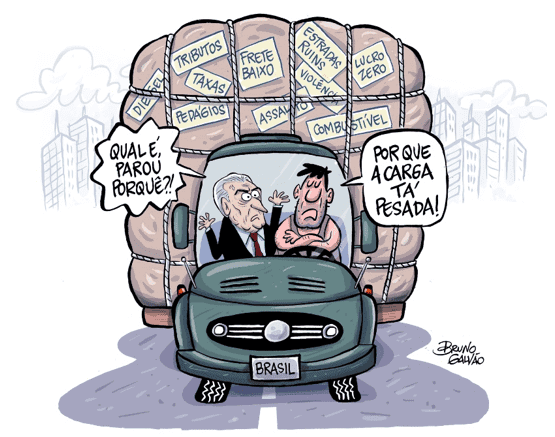
This cartoon criticizes the attitude of the former president of the Federative Republic of Brazil, Michel Temer, in the face of the increase in fuel costs. Truckers, at the time, pressured the government to reduce Diesel to 1.99 and Gasoline to 2.99, as prices exceeded $4.00 at the gas stations. In addition, it is observed, in the texts written, purposely, on the truck body, that truck drivers faced other difficult situations that made the load “heavy”. Therefore, those who experienced this strike followed the information on the news and, even if for some reason they could not express themselves verbally, they would attribute some meaning to the cartoon.
On the other hand, it appears that, in some cartoons, only non-verbal language is used, however, the image and its relationship with everyday events do not prevent the possibility of interpretation. In the figure below, for example, the physical distancing of the couple is denounced, where the love relationship leaves the real world for the virtual one due to the advance of technology:
Figure 2. Cartoon: Education and Technology
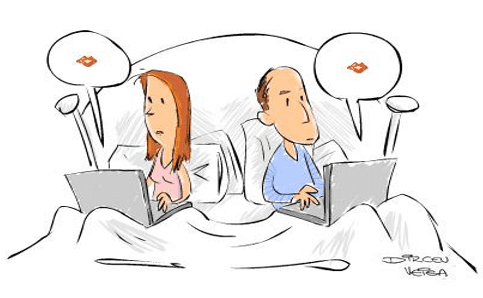
Bearing in mind the multisemiotic appearance of the cartoon, the reader may have the discernment to “infer and justify the effect of humor, irony and/or criticism through the ambiguous use of words, expressions or ambiguous images, of clichés, of iconographic resources, of score, etc.” (BRASIL, 2021, p. 141), when you do a visual reading of it.
The cartoons show meticulous artistic work in the field of visual arts, capable of arousing the reader’s interest and curiosity to understand them and, in this way, develop criticality regarding social facts. Furthermore, regarding the visual art worked on in the creation of the caricature, one can reflect on the cognitive functions of its subject/author who, according to Arnheim (1980, p. 195), the “(…) sensory perception of the outside world, the elaboration of experience and memory thinking (…)” is capable of giving life and meaning to a material, which has as its backdrop the latest political and social events that are reported by the media.
In the textual production of the cartoon, in the first moment, the apprehension process begins with the subject/author, both in the mental elaboration of his abstract creation process, as well as his composition process. Accordingly, Queluz (2008, p. 52 apud BOOS QUADROS, 2008) says that “the author of cartoons is first and foremost a reader, a reader of the newspaper or magazine that publishes it”. In this way, the author creates a discourse about another discourse addressed in the newspaper which, in other words, allows “reading the spectacle of the world that the newspaper offers us” (LANDOWSKI, 1995, p. 81 apud BOOS QUADROS, 2008, p. 52 ).
In a second moment, there is what can be called the revelation of the cartoon to the subject/reader, the receiver, in whose mind the attribution of meaning and reflection on this symbolic representation of reality takes place. Thus, this subject’s perception opens up to the artistic representation of the caricature image, as well as to the textual message that may be linked to it − which figures contours of the current sociocultural context −, entering into a kind of clash of senses, where fruition of art and the experimentation of burlesque are mixed.
3.1 THE CARTOON AS A TEACHING OBJECT
In this section, there is a brief exposition of the author’s experiences while working with some cartoons, in the years 2017 and 2018, in Portuguese Language classes, with students who have intellectual disabilities enrolled in the Youth and Adult Education (EJA).
From this experience, it was noticed that the cartoon works as an input capable of triggering the reader’s memory, who often needs an image of the object to be able to interpret a text and remember some current event. Thus, working with this type of text can significantly contribute to the cognitive and intellectual development of students, as the presence of non-verbal language stands out during practice.
The cartoons that were worked on had as their theme recent facts and events that, in a way, affected the lives of students, (see Fig. 3 “World Cup”, Fig. 4 “Truck drivers’ strike”, Fig. 5 “ Campeonato Mineiro”, that is, facts that marked and continue to build the history of the country); and also instigated their cognitive and behavioral aspects, by demonstrating the ability to correlate some aspect of the cartoons to events reported by the media. Below are the cartoons that were part of some pedagogical practices in loco:
Figure 3. The 2018 World Cup
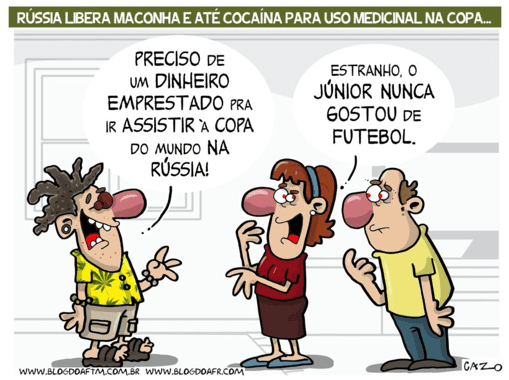
Figure 4. The truckers’ strike/2018
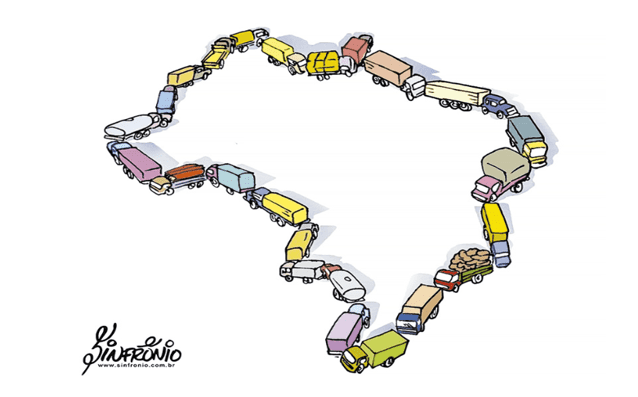
Figure 5. The Minas Gerais Championship/2017
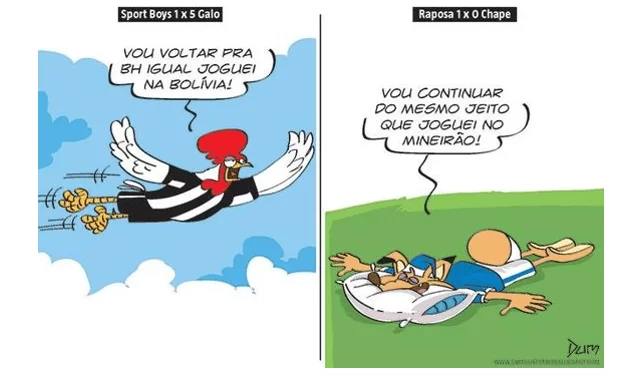
The use of this textual typology, which comes from the journalistic domain, in that class, activated the students’ prior knowledge, leading them to practice their basic reading skills − making inferences and relating the text to the context. With that, they developed a bit of criticism, as well as an attentive and extensive look at the relationships that take place in the world, at a social, economic and cultural level. The BNCC in the area of Languages and Technologies highlights the relevance of the “journalistic-media field” for the training of students because it
caracteriza-se pela circulação dos discursos/textos da mídia informativa (impressa, televisiva, radiofônica e digital) e pelo discurso publicitário. Sua exploração permite construir uma consciência crítica e seletiva em relação à produção e circulação de informações, posicionamentos e induções ao consumo (BRASIL, 2021, p. 479-490).
It was observed, therefore, that the students’ interaction in the classroom, both with the language used in the cartoons and with the images conveyed by them, was built on the basis of the awareness that it was not just about drawings in a row sentences, or vice versa, but rather messages directed at specific subjects and situations.
3.2 COGNITIVE DEVELOPMENT AND CARTOON
We saw above that cognition/memory has a social dimension of fundamental importance for the thinking being to be able to attribute meaning to linguistic signs in a given context. This is due to the fact that the same graphic-visual representation can have different meanings depending on the context of use, for example, the perfect homonyms: weapon (instrument of struggle or defense) and weapon (verb to arm), sleeve (part of the shirt ) and mango (mango fruit)[9]. Therefore, for the meaning to be properly given, the cognitive system needs to be activated in the interaction between the text and the message receiver.
In general terms, everyone is born with a predisposition to develop language and have the ability to interpret different types of texts that circulate in their environment. Nonetheless,
Adquirir uma língua em primeiro lugar requer uma vasta gama de habilidades cognitivas básicas de primatas tais como percepção, categorização, memória, compreensão relacional, resolução de problemas e assim por diante. (…) requer a forma unicamente humana de cognição social – compreender as outras pessoas como agentes intencionais como si próprio- sem a qual não haveria nenhuma forma de atividade simbólica ou cultural como a do ser humano. (…). (SOUZA, 2012, p. 211).
When it comes to metaphor, it is known that its interpretation requires a little more of the individual’s ability to interpret and assign meaning, requiring the subject to be inserted in a community where the meaning of the metaphor originated with the daily use of metaphor. language so that you can understand it. According to Ferrari (2014, p. 91), “the metaphor is related to the notion of perspective, as different ways of conceiving particular phenomena are associated with different metaphors”.
In the case of cartoons, which are also a type of visual metaphor, the image presented is designed to characterize the messages to be disseminated. To the detriment of this, the thinking subject will make his way to interpret a cartoon based on the information about the subject contained in his mind. In addition, with its ironic character, it brings something that is implied, which requires the reader to make an effort to understand its meaning, which is accompanied by an image.
The genre thus conveys an image full of meanings, which, according to Massaud Moisés (2004, p. 235), “would correspond, like a photograph, to the one formed in the mind of the writer in contact with physical reality.” In this way, at the moment of his/her encounter/confrontation with this image, the subject/spectator is faced with reality, which, in a way, can be thought of as being the facts of the political and social daily life, those that are highlighted media in many ways.
In this sense, the peculiarities of the cartoon image can lead subjects to sensorially experience both their inner world and what surrounds them. This would happen, among others, in two ways: the first would be a kind of critical process, in which he would make deductions arising from his understanding; the second, a remembrance (either because of having experienced it or because of having witnessed it) of aspects already contemplated at some point. Regarding the power of remembrance of images, Jorge Iskandar comments:
Nossa percepção da realidade através do desenho é um ato individual sustentado em fragmentos, vivenciados pela história de cada indivíduo. Isto é: as imagens só podem ser recebidas através das experiências vividas anteriormente por cada um, e que se encontram gravadas intransferivelmente na alma de cada pessoa. É a imaginação entrando em cena (ARBACH, 2007, p. 52).
However, one cannot think of the genre only in its imagery aspect, since
A charge constitui um gênero textual interessante, que combina a linguagem verbal e a não verbal […]nela estão inscritas diversas informações construídas a partir de um interessante processo intertextual que obriga o interlocutor a fazer inferências e a construir analogias, elementos sem os quais a compreensão textual ficaria comprometida. (PEREZ, s.d.).
Concerning this, it appears that the surrounding world or the subject’s socio-cultural surroundings would be put to the test by activating their critical sense, motivated by contact with the cartoon. This contact exerts an influence on this subject, who develops his ability to read events, other subjects and himself. It is understood, therefore, that he leaves the state that could be called mental idleness to give himself, with commitment, to the exercise of reflection. In this sense, it can be said that the cartoon, as a strong expression that it is, communicates to the subject a new perspective on life, allowing him a new awakening to reality, be it sociopolitical or cultural.
4. FINAL CONSIDERATIONS
In view of the above, it is inferred that the reflections addressed in this work help to perceive the particularities that involve the reader’s cognitive capacity.
The emphasis given to intellectual disability is a consequence of the observances of educational practices in loco with the cartoon during the work with the Portuguese language, carried out with students of the EJA modality, whose language learning was compromised due to some intellectual disability. Perhaps, it is observed that this problem added to the abstraction of language causes these students to have significant difficulty in following the linearity of regular education during their school training course.
However, this does not make this student a functionally illiterate subject who is often stigmatized as a donkey, because he understands the message and when he does not have words to write and say about a certain subject, he can express his understanding with a smiling, pointing to the image, to some object, drawing, etc.
In this context, this article aimed to bring some notes and reflections on the use of the textual genre cartoon as a teaching object to stimulate reading and the ability to interpret texts by students who have some type of intellectual disability, aiming to answer: How can cartoons help students, especially those who have some limitations in terms of mental ability, to develop their intellectual capacity?
In response to the problem raised, it appears that due to the fact that the cartoon has non-verbal and verbal language and is always constituted by a mixed language, the possibility that the text is understood by readers who have difficulties is greater when compared to possibility of understanding texts presented only in verbal language and that are more complex.
It is also important to rescue these students with the facts that drove the appearance of the cartoon, activating their memory, so that they are able to make the necessary inferences during their study.
The cartoon is an attractive text to the reader’s eyes since it is formed based on political and social facts, disseminated by different means of communication, which are happening day after day and, consequently, marking and influencing history. Students are interested in the cartoon precisely because it reveals occurrences in a humorous, critical and caricatured way.
Finally, taking into account the need to work with relevant texts that bring temporal themes in order to understand the students’ knowledge about events in the political, economic and social spheres and to develop their reading and interpretation capacity, critical sense, the work with the cartoon becomes significant. The teacher can work with various characteristics of language and, somehow, develop a study of language in a less abstract way, making the different forms of text that exist, as well as their meanings, perceptible to students.
REFERENCES
ALBUQUERQUE, Nonato. CHARGES. Greve de caminhoneiros gera charges na mídia. Blog Gente de Mídia, 2018. Disponível em: https://gentedemidia.blogspot.com/2018/05/charges-um-salve-para-o-sinfronio-pela.html. Acesso em: 13 jul. 2022.
ARBACH, Jorge Mtanios Iskandar. O fato gráfico: o humor gráfico como gênero jornalístico. Tese (Doutorado em Ciências da Comunicação. Jornalismo e Linguagem) – Escola de Comunicações e Artes, Universidade de São Paulo. São Paulo, p. 252, 2007.
ARNHEIM, Rudolf. Arte e percepção visual: uma psicologia da visão criadora. Tradução Ivone Terezinha de Faria. 2. ed. São Paulo: Pioneira, 1980.
BRASIL. Base Nacional Comum Curricular. Ministério da Educação. Brasília, 2018.
BRASIL. Base Nacional Comum Curricular. Ministério da Educação. Brasília, 2021.
BAKHTIN, Mikhail. Marxismo e filosofia da linguagem. (1ª edição de 1929). Tradução de Michel Lahud e Yara Frateschi Vieira. São Paulo: Hucitec, 2004. In: BAKHTIN, Mikhail. A estética da criação verbal. São Paulo: Martins Fontes, [1953] 2003.
BRAIT, Beth. Ironia em perspectiva polifônica. Campinas: Editora UNICAMP, 1996.
BOOS QUADROS, Cynthia Morgana. As relações interdiscursivas entre a arte, a política e o jornalismo: as charges de Cao Hering. Dissertação (Mestrado em Ciências da Linguagem) – Universidade do Sul de Santa Catarina – Unisul. Palhoça, SC, 2008.
CID-10. Classificação de transtornos mentais e de comportamento da CID – 10: descrições clínicas e diretrizes diagnósticas. Porto Alegre: Artmed, 1993.
CÂMARA JUNIOR, Joaquim Mattoso. Dicionário de lingüística e gramática. 7. ed. Petrópolis: Vozes, 1977.
CLAVÉ, Christophe. O QI médio da população mundial diminuiu nos últimos 20 anos. Das Culturas, 2020. Disponível em: https://dasculturas.com/2020/12/20/o-qi-medio-da-populacao-mundial-diminuiu-nos-ultimos-vinte-anos-christophe-clave/. Acesso em: 31 jun. 2022.
DUM. Charge do Dum (Zona do Agrião) sobre a final do Campeonato Mineiro. Postado em 04 de maio 2017. Disponível em https://i.pinimg.com/564x/39/07/d2/3907d22c6c71413cf0908eb48355f85d.jpg . Acesso em 31 jul. 2022.
FERRARI, Lilian. Introdução à linguística cognitiva. 1. Ed. São Paulo: Contexto, 2014.
GERALDI, João Wanderley. Linguagem e ensino – exercícios de militância e divulgação. Campinas: Mercado de Letras, 1996.
GUIMARÃES, Elisa. Linguagem verbal e não verbal na malha discursiva. Bakhtiniana – Revista De Estudos Do Discurso, v. 6, p. 124-135, jul./dez. 2013. Disponível em: https://revistas.pucsp.br/index.php/bakhtiniana/article/view/13967. Acesso em: 31 jul. 2022.
GRUPO EDITORES BLOG. # Charge: Rússia libera maconha e até cocaína para uso medicinal na copa. Blog do AFTM, 2018. Disponível em: https://blogdoaftm.com.br/charge-russia-libera-maconha-e-ate-cocaina-para-uso-medicinal-na-copa/. Acesso em: 13 jul. 2022.
HIGASHIDA, Naoki. O que me faz pular. Edição digital. Rio de Janeiro: Intrínseca, 2013. Disponível em: https://livrogratuitosja.com/wp-content/uploads/2021/03/O-que-me-faz-pular-by-Naoki-Higashida-z-lib.org_.pdf. Acesso em: 31 jul. 2022.
MAZIÈRE, Francine. A análise do discurso: história e práticas. Trad. Marcos Marcionilo. São Paulo: Parábola Editorial, 2007.
MEDICINA. Cognição: o que é cognição. Significados. Disponível em: https://www.significados.com.br/cognicao/. Acesso em: 30 jul. 2022.
MOISÉS, Massaud. Dicionário de termos literários. 12ª ed. rev. e ampl. São Paulo: Cultrix, 2004.
MOTA, Leonilson. Charge do dia: Greve dos caminhoneiros. Blog do Leonilson Mota, 2018. Disponível em: http://www.barradocordanoticia.com/charge-do-dia-greve-dos-caminhoneiros/. Acesso em: 21 jun. 2022.
PEREZ, Luana Castro Alves. Charges. Brasil Escola, s.d. Disponível em: https://brasilescola.uol.com.br/redacao/charges.htm. Acesso em: 08 set. 2018.
SANTOS, Ellis Regina. Charges sobre tecnologia. Blog educação e tecnologia, 2014. Disponível em: https://jessicaellisekellen.wordpress.com/2014/07/31/charges-sobre-tecnologia/. Acesso em: 13 jul. 2022.
SAUSSURE, Ferdinand de. Curso de lingüística geral. Organização de Charles Bally e Albert Sechehaye com a colaboração de Albert Riedlinger. Trad. de Antônio Chelini, José Paulo Paes e Izidoro Blikstein. 24ª ed. São Paulo: Pensamento-Cultrix, 2002.
SAUSSURE, Ferdinand de. Curso de Lingüística Geral. São Paulo: Cultrix, 1995 (1916).
SOUZA, André L. A chave está na cognição social. Porto Alegre: Instituto de Letras UFRGS, 2012.
APPENDIX – REFERENCE FOOTNOTE
2. Educação de Jovens e Adultos (EJA).
3. Base Nacional Curricular Comum (BNCC).
4. “Cognitive functions play a fundamental role in the cognitive process and work together so that we can acquire new knowledge and create interpretations. Some of the main cognitive functions are: perception, attention, memory, thinking, language and learning.” MEDICINE. Cognition: what is cognition. Significados. Disponível em: https://www.significados.com.br/cognicao/. Acesso em 30/07/2022.
5. Due to the abstraction of linguistic signs mentioned by Saussure (2002), people with intellectual disabilities often need other stimuli that go far beyond the text, whose language is verbal, in order to be able to understand the message and dialogue with it. These stimuli can be: objects, drawings, the communication situation, the theater, etc.
6. Língua Brasileira de Sinais (LIBRAS).
7. Naoki Higashida (Kimitsu, 1992) is a Japanese writer known for, as a result of his non-verbal autism, writing using an alphabetic board. He was diagnosed with severe autism at the age of 5, in 1998. At the same time, he started attending a school for children with disabilities.
8. “The poorer the language, the more thought disappears” (CLAVE, 2020).
9. Portuguese language grammar: “homônimos perfeitos: arma (instrumento de luta ou defesa) e arma (verbo armar), manga (parte da camisa) e manga (fruto da mangueira).”
[1] Postgraduate, graduation. ORCID: 0000-0003-0039-5113.
Sent: August, 2022.
Approved: September, 2022.


